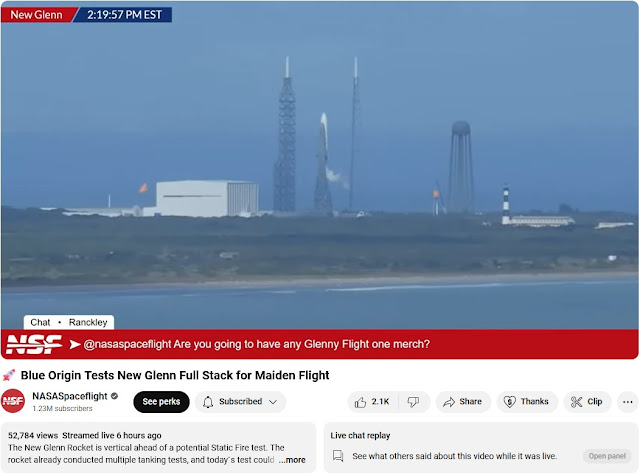As far as I can tell, Blue Origin's first New Glenn rocket did
something today, it's just hard to know what it actually was.
According to the local newspaper,
Florida Today, it seems like they did a wet dress rehearsal (WDR), fully fueling the vehicle and doing everything that must happen before they
start the engines, without actually starting the engines for their static fire
test.
Thursday afternoon, the massive 320-foot-tall New Glenn rocket sat on Launch Pad 36 at Cape Canaveral, steam billowing from it − indicating fuel was being poured into the rocket.
Blue Origin's promised wet dress rehearsal may have been underway, where New Glenn would be fueled, but not launched. After multiple hours of steam venting from the rocket, all activity stopped − signaling they concluded the test.
The only problem is that I just find no confirmation that's what they did from
the top four news sources I regularly check and a visit to the
"News" page on Blue Origin's website. I see
a video from NASA Spaceflight
that has visuals of the rocket with "steam billowing from it" and the narrators refer to it as a WDR. The video
is about 90 minutes long and the steam is apparent from 10 minutes in to 60
minutes - approximately in both times.
We know that Blue Origin is pushing to try to launch before the end of this year, now only 12 days away if you count working on Christmas. It's possible that IF this was a WDR and IF it was successful that they could go to a static fire quickly, although I can't estimate how long that might take. I only know if it wasn't successful, it will take longer to get to the static fire and first launch.
Screen capture of the test from NASAspaceflight.com's video. The local time at the top left is close to 30 minutes on the sliding bar visible on the video when you're manually adjusting the times.
The New Glenn has been talked about for quite a long time. While I have no
idea when I heard about it for the first time it seems like it was at least as long as this has been a primarily space-oriented blog. It might well be the first rocket talked about as
being a reusable multistage rocket. More powerful
and larger than the Falcon Heavy, the New Glenn will feature seven of the BE-4
engines also used on ULA’s new Vulcan. There are two and three
stage versions with different payload capacities, this one seems to be the two
stage version. In addition to being the first flight of any version of the New
Glenn, this NG-1 mission will also be aimed at certifying the vehicle for
National Security missions.

Watched a v-clip, day before yesterday i think, where enough ice built up on the first stage it covered over some of the letters on their logo. Took it for a good sign significant progress was in process.
ReplyDeleteIts got to be stressful on a structure like these big rockets going from ambient to super cryo temps plus the actual weight of the liquid. If you could stand near the rocket, just imagine all the creaking and groaning going on as its filled.
It would be fun to hear what it sounds like. Use some microphones and remote monitoring instead of standing where a giant chunk of ice could fall on your head. The guys on NASASpaceflight talk about the way the enormous metal walls of the Vehicle Assembly Building make different sounds depending on if the Falcon 9 launches from pad 39A or SLC-40. You just have to be there.
DeleteHear you, you are fortunate to live near by, only ever got to see an earlier shuttle launch, incredible how you feel the sound from the roar of those 5 engines, and how quickly it gets moving zoom zoom fast, all that tonnage, amazing feat.
Delete"Steam"? Of course you (and they) mean liquid oxygen boiloff...or liquid nitrogen if they're just faking it.
ReplyDeleteI thought what they were referring to was the condensation of Florida's humidity on the cold body of the rocket.
DeleteThat would be the source of the ice, yes. The clouds venting sideways from the rocket are LOX plumes (if a real WDR, otherwise LN2) that keep the rocket at a given maximum internal pressure. The pic you have up there shows this.
DeleteCondensation will flow down along the cold body and spread out at the bottom along the ground, which you don't see in the pic but it's there.
Do you know if the methane tank is on top of the oxygen tank, or is it vice versa? I don't remember the advantages of one way over the other way.
Methane on the top. They use the term LNG - Liquefied Natural Gas, I assume, but that includes some ethane and I'd expect that to be an issue in rocket engine. I assume it burns somewhat differently and since everything about rocket design seems to exist on the hairy edge of getting every last fraction of a percent out of everything I just assume it meant liquid methane.
DeleteIn the NSF video I linked to there's a still image of a cutaway of the rocket at the 48 minute mark. (47:45 to 48:52)
Thanks! I didn't watch quite that far. And yes, "space is hard"...everything is on the hairy edge of working at all.
Delete